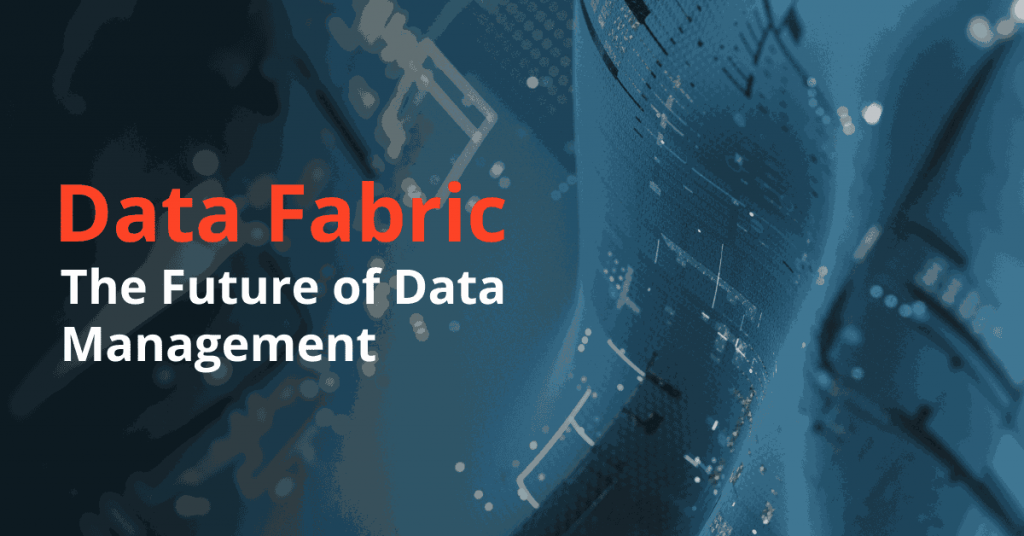Table of Contents
Data has become one of organizations’ most valuable assets. With the explosion of data, it has become increasingly important to manage, store, and analyze it effectively. Data fabric is an architecture that allows organizations to do just that. In this blog, we will explore the concept of data fabric, its architecture, solutions, and key use cases.
What is a Data Fabric?
Data Fabric Architecture
The architecture of a data fabric is composed of several interconnected components and layers, each playing a critical role in ensuring seamless data integration and management.
Data Ingestion Layer
The ingestion layer gathers data from various sources, including on-premises databases, cloud storage, streaming data, and third-party applications. It uses APIs, connectors, and data pipelines to ingest data at high speed and in real-time.
Data Integration Layer
The integration layer consolidates data from disparate sources and formats it into a unified structure. Advanced tools and technologies, such as AI and ML, automate this process, ensuring data consistency and reducing the need for manual intervention.
Data Storage Layer
The data is securely stored in a centralized repository, which could take the form of a data lake, data warehouse, or a combination of both. This storage layer is carefully constructed to be adaptable and able to expand as needed to handle the increasing amount and diverse types of data.
Data Processing and Analytics Layer
This layer processes and analyzes the integrated data, enabling organizations to derive meaningful insights. It encompasses various data processing engines and analytical tools that support real-time analytics, batch processing, and advanced analytics like predictive and prescriptive analytics.
Data Governance and Security Layer
Governance and security are crucial to maintaining the integrity and privacy of the data. This layer includes policies, procedures, and tools to enforce data quality, compliance, and security measures. It guarantees that solely authorized users have access to data and that all data interactions are monitored and logged.
Data Access and Consumption Layer
Finally, the data access layer makes the data available to end-users and applications. This layer provides various interfaces, such as dashboards, APIs, and visualization tools, enabling users to easily access and consume data as per their needs.
By integrating these components and layers into a cohesive framework, data fabric enables seamless data integration and management. The unified architecture ensures data flows smoothly across sources, is reliably transformed and stored, and is readily accessible for analytics and decision-making.
The automation of data processes through AI and ML further enhances efficiency, reducing the burden of manual tasks and allowing organizations to focus on leveraging data for strategic advantage.
Leading Data Fabric Solutions
Several leading data fabric solutions in the market offer comprehensive features and benefits that cater to various organizational needs. Here are some notable examples:
IBM Cloud Pak for Data
Features
- Integrated data and AI platform
- Automated data integration and governance
- Support for multi-cloud environments
- AI-powered insights and analytics
Benefits
- Simplifies data management across hybrid cloud environments
- Reduces reliance on manual data processes through automation
- Enhances data security and governance
- Accelerates data-driven decision-making with AI capabilities
Talend Data Fabric
Features
- A platform for data integration, integrity, and governance.
- Real-time data streaming and batch processing
- Extensive connectivity with various data sources
- Cloud-native architecture
Benefits
- Ensures high data quality and reliability
- Provides seamless integration with cloud and on-premises sources
- Offers real-time data insights
- Facilitates compliance with regulatory standards
Informatica Intelligent Data Management Cloud
Features
- Comprehensive data integration and management
- AI-driven data mapping and quality assurance
- Scalable architecture suitable for large enterprises
- Advanced data privacy and protection features
Benefits
- Streamlines complex data management tasks
- Enhances data quality and accuracy with AI
- Supports scalability for growing data volumes
- Offers robust security and privacy controls
Microsoft Azure Synapse Analytics
Features
- Unified analytics service integrating big data and data warehousing
- Built-in data governance and security
- Real-time analytics and business intelligence
- Seamless integration with other Azure services
Benefits
- Provides a holistic view of organizational data
- Delivers real-time insights and advanced analytics
- Enhances collaboration and data sharing within organizations
- Offers strong security and compliance features
Cloudera Data Platform
Features
- Hybrid and multi-cloud data management
- End-to-end data lifecycle management
- Real-time data processing and analytics
- Unified governance and secure access controls
Benefits
- Supports a wide range of data sources and environments
- Simplifies data lifecycle management from ingestion to analytics
- Ensures secure and compliant data usage
- Facilitates real-time insights and decision-making
Choosing the Right Data Fabric Solution
When selecting the right data fabric solution, businesses should consider several key factors:
- Integration Capabilities: Assess the solution’s ability to integrate with existing data sources and systems, including on-premises and cloud environments.
- Scalability: Ensure the solution can scale to handle current and future data volumes and complexity.
- Automation and AI: Look for advanced features, such as AI and machine learning, that automate routine tasks and enhance data quality and governance.
- Security and Compliance: Evaluate the platform’s security measures and its ability to ensure compliance with regulatory requirements.
- Cost and ROI: Consider the total cost of ownership and the potential return on investment. Choose a solution that offers the best value for your specific needs.
- Ease of Use: Choose a user-friendly interface that simplifies data management and makes it accessible to various organizational stakeholders.
By carefully evaluating these factors and selecting a data fabric solution that aligns with their strategic goals, businesses can effectively leverage their data assets to drive innovation, enhance operational efficiency, and gain a competitive edge in the market.
Data Fabric Use Cases
Data fabric has various use cases across industries and business functions. Here are some examples:
- Real-time Analytics: Data Fabric’s ability to handle diverse data sources and provide real-time insights makes it a powerful tool for real-time analytics applications such as fraud detection, predictive maintenance, and dynamic pricing.
- Customer 360: Data fabric solutions integrate customer data from various touchpoints, such as social media, email marketing, and CRM systems, to provide a unified customer view. This helps businesses better understand customers and offer personalized experiences.
- Supply Chain Optimization: Data fabric integrates supply chain systems like inventory management, logistics tracking, and market trends to optimize operations for efficiency. This involves demand forecasting, inventory optimization, and route planning.
- Regulatory Compliance: Data Fabric’s centralized data management and governance capabilities make it an ideal solution for addressing regulatory compliance requirements. It can help businesses ensure data privacy, meet data retention regulations, and maintain audit trails.
Conclusion
In conclusion, the adoption of data fabric solutions offers significant advantages for modern businesses. By providing a unified and intelligent data management layer, data fabric ensures seamless data integration, enhances data accessibility, and strengthens data governance and security.
Adopting a data fabric architecture helps organizations manage complex data environments effectively, gain valuable insights, and stay competitive. As data volume and complexity increase, leveraging data fabric becomes essential for businesses to optimize data management and foster innovation. For more information on how our IT services can support your business, explore our comprehensive IT services.
Frequently Asked Questions
Everything you need to know about our IT services and solutions
Is data fabric only suitable for large enterprises?
No, data fabric solutions can be tailored to fit the needs of businesses of all sizes. Whether you have a small startup or a large enterprise, there is a data fabric solution that can support your data management and analytics needs.
Can data fabric integrate with legacy systems?
Yes, most data fabric solutions offer extensive connectivity options and can integrate with various legacy systems, databases, and applications.
Do I need advanced technical skills to use data fabric?
Some technical know-how may be needed for platform setup, but data fabric solutions often have user-friendly interfaces for non-technical users to handle data. Training and support resources are also provided to maximize the solution’s benefits.
Can data fabric handle different types of data, such as structured and unstructured?
Data fabric solutions can manage structured and unstructured data from databases, files, social media feeds, and other sources.
Which industry benefits the most from using data fabric?
No, any industry that deals with large volumes of diverse data can benefit from using a data fabric solution. This includes healthcare, finance, retail, manufacturing, and more. Overall, it is a crucial tool for any association looking to gain valuable insights from their vast amounts of data.



